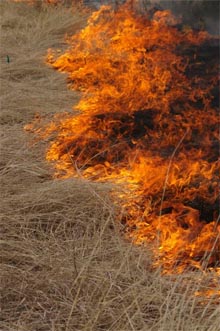Burning for Answers
 IN NATURE, fire has a number of benefits. It is part of the natural process which sustains native prairies. It volatizes nitrogen and releases phosphorous at the soil level, providing nutrients that are essential to plant life. It changes the dynamic of plant species, sometimes killing out invasive plants and controlling unwelcome brush.
IN NATURE, fire has a number of benefits. It is part of the natural process which sustains native prairies. It volatizes nitrogen and releases phosphorous at the soil level, providing nutrients that are essential to plant life. It changes the dynamic of plant species, sometimes killing out invasive plants and controlling unwelcome brush.
Ecology scientists at the Wildflower Center are carefully setting some prairie research plots ablaze this month, in continuing research about the benefits of prescribed fire implemented at different times through the year .
In nature, fire doesn’t usually occur in winter. Wildfires normally result from lightning, and the chance of lightning strikes in February in Austin are low. Lightning peaks between May and August. But winter burning has some advantages mainly because it encourages grass regrowth – important for the cattle industry– and also because of weather conditions and the fuel provided by grasses.
With Restoration Ecologist Mark Simmons as burn-boss and a well-trained fire team, the Center is permitted for prescribed burns and carefully follows safety precautions. No burns are undertaken without a meticulous check of weather conditions before, during and after the burn and the presence of the Austin Fire Department. Relative humidity is a key factor, and ecologists test the humidity with a sling- psychroometer and calculate the moisture in the grass to be burned. Then, a tiny test plot is lighted to observe how the fire performs. After that a strip is burned around the perimeter as a fire break before starting the main burn.
This month, the team is burning several 1.5 acre plots that were last burned four years ago.
“Primarily, we are interested in techniques that are effective in restoring and sustaining native plant communities,” Simmons said. “We hope to demonstrate the short and long-term effectiveness of historical factors such as summer wildfires as well as contemporary land management practices such as winter burning and continuous grazing.”
This research has determined that summer burns can be selective and effective in controlling invasive grasses such as King Ranch Bluestem and excellent at reducing the types of vegetation which can cause wild fire. The Wildflower Center program has set a precedent for summer burning on other sites, including the City of Austin Water Quality Protection Lands and Fort Hood, as well as a number of ranches.

